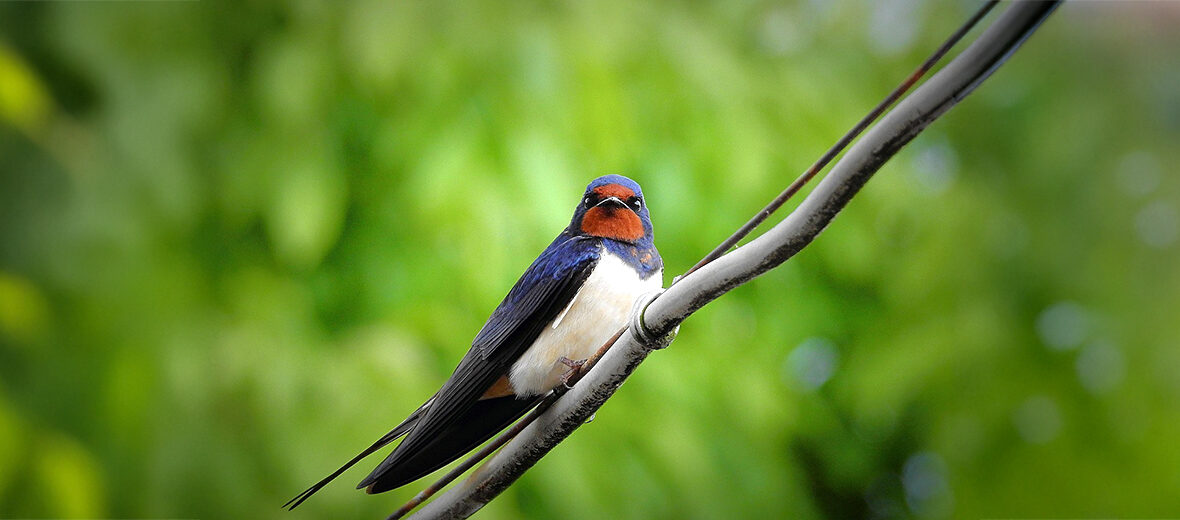
The barn swallow is the most populated swallow of them all, with individuals in Canada, United States, Mexico, Central America, South America, Europe, Asia, Africa, Australia, and even vagrant populations in Antarctica. Being so widespread puts them in harm’s way though, as they face the threats of habitat loss and destruction at the hands of farming, ranching, dams, and water management; hunting; trapping; invasive species, and with them predation and disease; pollution, both air and water; and climate change, that can cause severe weather patterns and habitat alteration. However, these birds are abundant enough to be listed as Least Concern by the IUCN.
First the Stats…
Scientific name: Hirundo rustica
Weight: Up to .71 ounce
Length: Up to 7.5 inches
Wingspan: Up to 13.5 inches
Lifespan: Up to 8 years
Now on to the Facts!
1.) These swallows number an estimated 487,000,000 wild individuals, but their numbers are decreasing.
2.) There are 6 recognized subspecies of barn swallow: H. r. rustica, H. r. transitiva, H. r. savignii, H. r. gutturalis, H. r. tytleri, and H. r. erythrogaster.
3.) The barn swallow is the official bird of Austria and Estonia.
4.) They were originally described by Carl Linnaeus in his 10th edition of Systema Naturae, in 1758.
5.) These birds prefer habitats with open country that have low vegetation, like pastures, meadows, and farmland, preferring to be close to water. These birds avoid heavily wooded or precipitous areas and heavily built-up areas.
But wait, there’s more on the barn swallow!
6.) They also prefer to have access to open structures like barns, culverts, and/or stables to allow for nesting sites, and exposed areas like wires, roof ridges, and/or bare branches that are used for perching.
7.) Barn swallows are semi-colonial and gather into flocks of up to several dozen pairs.
Did you know…?
Some populations of barn swallows can migrate up to 6,000 miles from northern areas to the south.
8.) They breed at the same location year after year, seeing as old mud nests are highly valued.
9.) Nests are constructed from mud, hair, and other nearby materials.
10.) Barn swallows are monogamous (mate for life).
But wait, there’s still more on the barn swallow!
11.) Females lay up to 7 eggs that hatch in up to 27 days.
12.) The chicks fledge (leave the nest) in up to 24 days.
Did you know…?
The female’s songs are much shorter than male’s songs, and are typically only produced during the earlier part of the breeding season.
13.) Large flies, flying ants, beetles, crickets, dragonflies, grasshoppers, and moths are all feasted upon; with flies making up to 70% of their diet.
14.) The barn swallow drinks by literally skimming low over rivers and/or lakes and scooping up water with its open mouth.
15.) Their songs are a combination of twitter warbles, followed by P-syllables, Q-syllables, and/or trilled series of pulses, coined the “rattle”. Their rattle is occasionally followed by a terminal “Ω-Note”.
But wait, there’s still a bit more more on the barn swallow!
16.) Barn swallows are usually afflicted with several species of lice.
17.) Predators include peregrine falcons, greater false vampire bats, African hobbies, and even African tigerfish (that leap from the water as the swallows are flying low to scoop up drinking water.
Did you know…?
The proverb about the necessity for more than 1 piece of evidence dates back to Aristotle’s Nicomachean Ethics: “For as 1 swallow or 1 day does not make a spring, so 1 day or a short time does not make a fortunate or happy man.”
18.) The barn swallow is a pretty bird due to their feeding on a variety of flying insects they have therefore been long tolerated by humans when they share their buildings for nesting.
19.) Getting a swallow tattoo is a tradition among sailors as a symbol of a safe return. The tradition was that a mariner would get a tattoo of this fellow wanderer after sailing 5,000 nautical miles. A second swallow would be added after 10,000 nautical miles at sea, and so on.
20.) Barn swallows are long-distance migrants, traveling to warmer climates during the winter. They can migrate over distances of up to 7,250 miles!
Now a Short Barn Swallow Video!
Be sure to share & comment below! Also, check out the Critter Science YouTube channel. Videos added regularly!
Want to suggest a critter for me to write about? Let me know here.
Some source material acquired from: Wikipedia & IUCN




